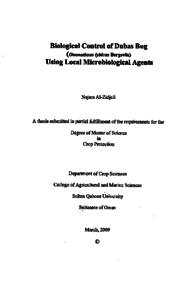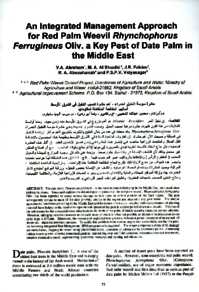وثيقة
Biological control of Dubas bug (Ommatissue lybicus Bergevin) using local microbiological
الناشر
Sultan Qaboos University
ميلادي
2009
اللغة
الأنجليزية
الموضوع
الملخص الإنجليزي
Dubas bug biocontrol using different locally isolated microbial agents was examined by testing their efficacy against the different stages of Dubas bug, first in vitro at the laboratory level, then in vivo under controlled conditions within small cages and finally under insect proof shade in field conditions. The general objective of this research was to develop a safe biocontrol method in order to preserve the bio-ecological balance, and to reduce the economical damage induced by the Dubas bug on date palm trees and to reduce chemical pesticide use. Different microbial treatments were tested by ground spray comparative to an untreated control, at different generation period targeting eggs, nymphs or adults. Egg hatching, nymph development, adult number and sex-ratio, as well as induced damage were weekly recorded to evaluate the efficiency and the sustainability of the tested microbial treatments. PCR and SEM investigations showed that Dubas bug is associated with symbiotic/mutualistic bacteria Arsenophonus sp. (DBY06). Screening Dubas bug for specific symbionts confirmed the occurrence of Arsenophonus within all populations and different stages using PCR sequence of specific Arsenophonus probes. This newly assumed symbiotic DBY06 bacterium, naturally associated with Dubas bug, is reported for the first time in Oman. The effect of Enterobacter cloacae (DBY05) on eggs and Arthrobacter aurescens (DBW05) on adults was confirmed. However, the beneficial effect was not sustainable, because reducing Dubas bug adult number, resulted in the Dubas bug population building-up at the next generation. Effect of DBY06*, an antagonistic bacteria toward Arsenophonus (DBY06) showed the greatest effect on Dubas bug egg hatching rates, nymphs and adults densities, as well as on the Dubas bug damage observed on infested date palm seedlings. Research investigation on Dubas bug biological control in Oman fits with the Symbiont-Based Protection (SyBaP) or "symbiotic control", a new approach with the aim of using insect symbionts for the control of major agricultural pests.
الوصف
Thesis
المجموعة
URL المصدر
الملخص العربي
الخلاصة حشرة الدوباس من أهم الآفات التي تصيب النخيل بسلطنة عمان، حيث تتسبب في خسائر اقتصادية كبيرة مما يستوجب استخدام الرش الجوي للمبيدات على نطاق واسع بما في ذلك من تأثير سلبي على الإنسان و الحيوان والبيئة بصفة عامة. رغم تواجد الحشرة بالسلطنة منذ سنوات عديدة، لم يتوصل البحث العلمي إلى إيجاد بدائل فعالة تحد من تكاثر هذه الحشرة بصفة مستدامة رغم تسجيل عدد من الأعداء الطبيعية المتطفلة على مختلف أطوار الحشرة. يهدف هذا العمل إلى تطبيق استراتيجية بحثية جديدة تعتمد على دراسة خصائص التوازن البيولوجی الطبيعي للحشرة في مختلف مناطق السلطنة التي تمتاز عن غيرها بضعف الإصابة و قلة فقس بيض الحشرة و ذلك للبحث عن الكائنات الدقيقة المحلية التي يمكنها أن تصيب بيض الدوباس قبل الفقس في الفترات ما بين الجيلين الربيعي و الخريفي.
يعتمد هذا العمل البحثي على طريقة المسح الإحصائي الواسع في مختلف مناطق السلطنة لانتقاء و عزل وتعريف أهم الكائنات المتطفلة أو الممرضة البيض و الحشرات في مختلف الأطوار. تمت دراسة و تقييم فاعلية المكافحة الحيوية لمختلف الكائنات الدقيقة البكتيرية و القطرية التي تم عزلها من البيئة العمانية و ذلك لالتقاء أفضلها ضد البيض و الحوريات و الحشرات الكاملة، في ظروف مخبرية ثم شبه حقلية (على فسائل نخيل معزولة بغطاء واقي من الحشرات). أشارت النتائج إلى أهمية هذه الكائنات مثل (DBY05 البكتيريا (Enterobacter cloacae) في إمكانية تقليص فقس بيض الدوباس المعاملة على أوراق النخيل بصفة معوية بالمقارنة مع الشاهد. تمت تأكيد فاعلية المكافحة الحيوية لعشرة دوباس النخيل في الظروف الحالية باستخدام مستحضرات بكتيرية مختلفة. إضافة إلى البكتيريا (Enterobacter cloacae التي تصيب بيض فقد تم أيضا عزل سلالات أخرى من البكتيريا تصيب الحشرات الكاملة و التي عرفت ببكتيريا ب Arthrobacter aurescens
يعتمد هذا العمل البحثي على طريقة المسح الإحصائي الواسع في مختلف مناطق السلطنة لانتقاء و عزل وتعريف أهم الكائنات المتطفلة أو الممرضة البيض و الحشرات في مختلف الأطوار. تمت دراسة و تقييم فاعلية المكافحة الحيوية لمختلف الكائنات الدقيقة البكتيرية و القطرية التي تم عزلها من البيئة العمانية و ذلك لالتقاء أفضلها ضد البيض و الحوريات و الحشرات الكاملة، في ظروف مخبرية ثم شبه حقلية (على فسائل نخيل معزولة بغطاء واقي من الحشرات). أشارت النتائج إلى أهمية هذه الكائنات مثل (DBY05 البكتيريا (Enterobacter cloacae) في إمكانية تقليص فقس بيض الدوباس المعاملة على أوراق النخيل بصفة معوية بالمقارنة مع الشاهد. تمت تأكيد فاعلية المكافحة الحيوية لعشرة دوباس النخيل في الظروف الحالية باستخدام مستحضرات بكتيرية مختلفة. إضافة إلى البكتيريا (Enterobacter cloacae التي تصيب بيض فقد تم أيضا عزل سلالات أخرى من البكتيريا تصيب الحشرات الكاملة و التي عرفت ببكتيريا ب Arthrobacter aurescens
قالب العنصر
الرسائل والأطروحات الجامعية


